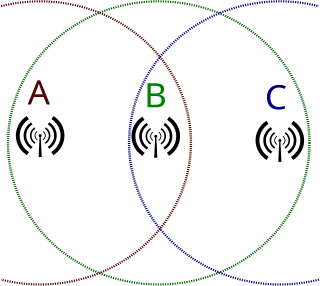
In radio technology, symmetrical double-sided two-way ranging (SDS-TWR) is a ranging method that uses two delays that naturally occur in signal transmission to determine the range between two stations: [1]

Radio is the technology of signaling or communicating using radio waves. Radio waves are electromagnetic waves of frequency between 30 hertz (Hz) and 300 gigahertz (GHz). They are generated by an electronic device called a transmitter connected to an antenna which radiates the waves, and received by a radio receiver connected to another antenna. Radio is very widely used in modern technology, in radio communication, radar, radio navigation, remote control, remote sensing and other applications. In radio communication, used in radio and television broadcasting, cell phones, two-way radios, wireless networking and satellite communication among numerous other uses, radio waves are used to carry information across space from a transmitter to a receiver, by modulating the radio signal in the transmitter. In radar, used to locate and track objects like aircraft, ships, spacecraft and missiles, a beam of radio waves emitted by a radar transmitter reflects off the target object, and the reflected waves reveal the object's location. In radio navigation systems such as GPS and VOR, a mobile receiver receives radio signals from navigational radio beacons whose position is known, and by precisely measuring the arrival time of the radio waves the receiver can calculate its position on Earth. In wireless remote control devices like drones, garage door openers, and keyless entry systems, radio signals transmitted from a controller device control the actions of a remote device.

A rangefinder is a device that measures distance from the observer to a target, in a process called ranging.

In communication systems, signal processing, and electrical engineering, a signal is a function that "conveys information about the behavior or attributes of some phenomenon". In its most common usage, in electronics and telecommunication, this is a time varying voltage, current or electromagnetic wave used to carry information. A signal may also be defined as an "observable change in a quantifiable entity". In the physical world, any quantity exhibiting variation in time or variation in space is potentially a signal that might provide information on the status of a physical system, or convey a message between observers, among other possibilities. The IEEE Transactions on Signal Processing states that the term "signal" includes audio, video, speech, image, communication, geophysical, sonar, radar, medical and musical signals. In a later effort of redefining a signal, anything that is only a function of space, such as an image, is excluded from the category of signals. Also, it is stated that a signal may or may not contain any information.
Contents
- Signal propagation delay
- Processing delay
- Calculating the range
- Verifying the range calculation
- See also
- References
- Signal propagation delay between two wireless devices
- Processing delay of acknowledgements within a wireless device
This method is called symmetrical double-sided two-way ranging, because:
- It is symmetrical in that the measurements from station A to station B are a mirror-image of the measurements from station B to station A (ABA to BAB).
- It is double-sided in that only two stations are used for ranging measurement – station A and station B.
- It is two-way in that a data packet (called a test packet) and an ACK packet is used.
The Transmission Control Protocol (TCP) is one of the main protocols of the Internet protocol suite. It originated in the initial network implementation in which it complemented the Internet Protocol (IP). Therefore, the entire suite is commonly referred to as TCP/IP. TCP provides reliable, ordered, and error-checked delivery of a stream of octets (bytes) between applications running on hosts communicating via an IP network. Major internet applications such as the World Wide Web, email, remote administration, and file transfer rely on TCP. Applications that do not require reliable data stream service may use the User Datagram Protocol (UDP), which provides a connectionless datagram service that emphasizes reduced latency over reliability.







